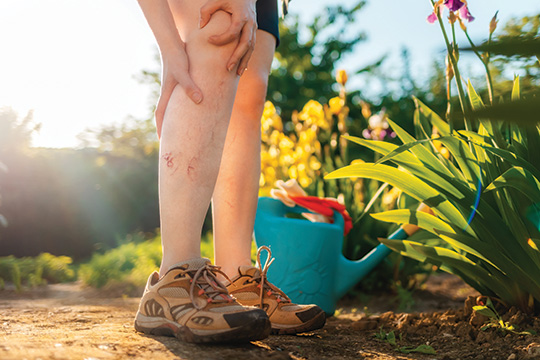May is National Women’s Health Awareness Month — an opportunity to encourage women to prioritize their wellbeing. Often overlooked, proper vein health can contribute to the satisfaction women feel with their overall health. Studies estimate that 40% of the U.S. population has chronic venous insufficiency, which occurs more frequently over the age of 50 and more often in women than men. Why, you may ask? While vein disease is common, it’s not normal, so let’s look at its causes and, most importantly, how to combat it.
WHAT CAUSES VEIN DISEASE?
A normal, healthy vein functions to pump blood back toward the heart. When a vein valve fails, blood begins to pool, creating venous reflux. This abnormal reversal of blood flow is known as venous insufficiency and creates those often painful and unsightly leg veins women (and men) despise.
While aging, heredity, and prolonged sitting and standing are three of the leading causes of venous insufficiency, and shared equally by both men and women, certain factors affect women more:
- Hormone changes resulting from puberty, birth control pills, pregnancy, menopause and hormone replacement therapy all can contribute to vein disease in women.
- High-heeled shoes, with which women have a love-hate relationship, limit the “pump” action of the foot and calf that promotes healthy circulation.
- Wearing spandex or tight-fitting clothes for prolonged periods can have adverse effects on leg veins by disrupting blood flow, increasing pressure on the veins, impairing circulation and hindering lymphatic drainage.
- Pregnancy increases venous disease symptoms and often becomes more prominent with each pregnancy.
HOW CAN YOU REDUCE RISK OF VEIN DISEASE?
Many of the causes of venous insufficiency are unavoidable, but women (and men) can employ these measures to reduce the risk of vein disease and maintain overall good health:
- Stay hydrated: When adequately hydrated, blood is less likely to thicken, reducing the risk of blood clots and supporting healthy blood flow throughout the body. Hydration also helps to maintain optimal blood volume and viscosity.
- Focus on fitness: Exercising frequently and maintaining a normal body mass index play a key role in fighting vein disease.
- Give the heels a rest: Enjoy high-heeled shoes occasionally, but choose a more leg- and foot-friendly shoe for daily wear.
- Wear compression stockings: No one loves compression stockings, but wearing them for prolonged periods of sitting (for work, while flying or driving), standing and during pregnancy can offer significant vein health benefits.
- Seek early intervention: When signs of leg swelling, achiness, fatigue, skin color changes and/or visible veins appear, get evaluated by a vein specialist. Venous issues will not resolve on their own or with a “magic cream.” Today’s vein treatments are quick, easy, safe and effective.
If leg veins are causing your legs to be unhealthy and taking a toll on your confidence, reach out to a board-certified vein specialist for the care you need. Treatments are minimally invasive, typically require no downtime and are mostly covered by insurance and Medicare. Healthy, happy legs are waiting for you!



